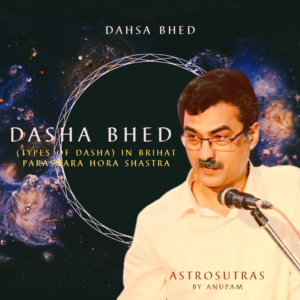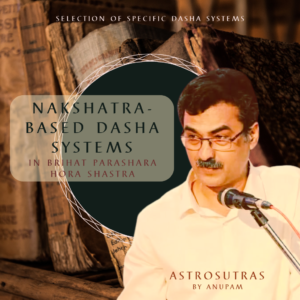Selection of Specific Dasha Systems in Brihat Parashara Hora Shastra (BPHS)
The Brihat Parashara Hora Shastra (BPHS) is one of the most comprehensive texts in Vedic astrology, detailing various planetary periods (Dashas) and their applications. While the Vimshottari Dasha is the most widely used, BPHS mentions several other Dasha systems that are applicable under specific conditions. The correct selection of a Dasha system is crucial for precise predictions, as each method highlights different aspects of a person’s life.
Understanding the Need for Different Dasha Systems
Different horoscopic conditions demand different Dasha systems. The selection is based on:
- The Birth Nakshatra (Moon’s Position)
- The Strength and Placement of Planets
- The Nature of the Query (General Life, Spiritual, Career, etc.)
- The Type of Chart (D-1, D-9, or other Divisional Charts)
BPHS classifies Dashas into three main categories:
- Nakshatra-Based Dashas (Udu Dashas)
- Rashi-Based Dashas
- Other Special Dashas
1. Nakshatra-Based Dashas (Udu Dashas)
These Dashas are based on the Moon’s Nakshatra at birth and are most commonly used for predicting life events.
A. Vimshottari Dasha (120 Years) – Default Dasha System
- When to Use:
- Recommended for most birth charts.
- Applicable when the Moon is in any Nakshatra at birth.
- Used for all four varnas (Brahmin, Kshatriya, Vaishya, Shudra).
- Why Use It?
- It provides an accurate timeline of karmic unfoldment in a person’s life.
- It is applicable universally unless a special condition calls for another Dasha.
B. Ashtottari Dasha (108 Years)
- When to Use:
- When Rahu is placed in a Kendra (1st, 4th, 7th, 10th house) or Trikona (5th, 9th house).
- Primarily used for people with highly spiritual or mystical tendencies.
- Why Use It?
- It emphasizes Rahu’s role in shaping karmic influences.
- Used for special cases where Vimshottari does not yield accurate results.
C. Shodashottari Dasha (116 Years)
- When to Use:
- When the birth is during the day, and the Ascendant lord is strong.
- More relevant for individuals with strong Sun influence in the chart.
- Why Use It?
- It is more suited for political, authoritative, or leadership inclinations.
D. Dwadashottari Dasha (112 Years)
- When to Use:
- When the Ascendant lord is Venus (i.e., Libra or Taurus Lagna).
- Why Use It?
- It gives better insights for people inclined towards arts, luxury, and relationships.
E. Panchottari Dasha (105 Years)
- When to Use:
- When Jupiter is in a Kendra or Trikona, and the birth occurs in Guru Hora (Jupiter’s hour).
- Why Use It?
- This Dasha gives deep spiritual insights and wisdom-related experiences.
F. Shatabdika Dasha (100 Years)
- When to Use:
- When the Moon is in Cancer or Leo at birth.
- Why Use It?
- It is used for determining material prosperity and social influence.
G. Chaturashiti Dasha (84 Years)
- When to Use:
- When the birth occurs during the day, and the Lagna lord is weak.
- Why Use It?
- It is effective for understanding karmic struggles and transformations.
2. Rashi-Based Dashas (Graha Dasha or Rashi Dasha)
These Dashas are based on the signs occupied by planets rather than Nakshatras. They are often used for rectifying timelines when Nakshatra-based Dashas fail to provide clarity.
A. Chara Dasha (Jaimini System)
- When to Use:
- Used for determining life directions, career, and destiny.
- Most effective in charts where planetary positions are unclear.
- Why Use It?
- It is not dependent on Nakshatra placement but focuses on zodiac signs and their ruling planets.
B. Sthira Dasha
- When to Use:
- More applicable for fixed signs (Taurus, Leo, Scorpio, Aquarius).
- Why Use It?
- Used for understanding stability, wealth, and long-term gains.
C. Yogini Dasha
- When to Use:
- Effective in predicting mystical, tantric, and secretive influences.
- Why Use It?
- Used by astrologers to understand occult experiences and hidden karmas.
D. Drig Dasha
- When to Use:
- When planetary aspects (Drishti) are stronger than planetary placements.
- Why Use It?
- Used for determining planetary influences beyond just sign placement.
3. Special Dashas for Unique Cases
BPHS also mentions conditional Dashas that should be applied when standard systems fail.
A. Kala Chakra Dasha
- When to Use:
- For highly spiritual individuals or those on a destined life path.
- Why Use It?
- It follows the natural order of the zodiac and provides a deeper spiritual roadmap.
B. Sudasa Dasha
- When to Use:
- When a person is experiencing sudden karmic shifts.
- Why Use It?
- Helps in determining hidden karmic debts and life lessons.
C. Mandook Dasha
- When to Use:
- For individuals undergoing rapid transformations or unpredictable changes.
- Why Use It?
- It analyzes sudden shifts in fortune and destiny.
D. Pindayu Dasha
- When to Use:
- When the lifespan and longevity need to be analyzed.
- Why Use It?
- Used for determining Ayurdaya (lifespan predictions).
FHow to Select the Right Dasha?
- Vimshottari Dasha → Default system, applicable in most cases.
- Ashtottari Dasha → When Rahu is strong in the chart.
- Shodashottari & Dwadashottari Dashas → When Ascendant lord and planetary strength demand.
- Rashi-Based Dashas (Chara, Sthira, Yogini) → Used when planetary aspects or signs dominate.
- Special Dashas (Kala Chakra, Mandook, Pindayu, etc.) → When dealing with specific life events, karmic insights, and lifespan calculations.
Conclusion
The selection of a Dasha system should be made carefully by analyzing the planetary positions, house strengths, Nakshatra placements, and specific life areas under scrutiny. BPHS provides a wealth of knowledge on different Dashas, but the key to accuracy lies in understanding the chart holistically and applying the most relevant Dasha accordingly.

